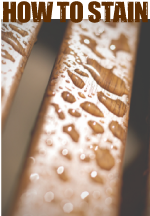Q. What are the dark streaks, spots, or blotches that are found on some parts?
A. These are mineral streaks, caused by the highly mineralized soil in the area where the hardwood trees grow. Some are caused by man-induced foreign objects sometime in the life of the tree; i.e. Bullet slugs, nails, tap holes for sap, initials of lovers, etc. We do not consider these marks as defects.
Caution: Rags with linseed oil are extremely flammable and can self ignite - washing rags does not eliminate this danger. Place rags in water and place outside the house until final disposal.
Q. How do you remove a "ding" (or "dig") or scratch from the top?
A. For small scratches or dings the easiest way is to put a little water on the ding or scratch. Wait a few minutes, then take a metal cap such as a bottle cap and place it over the water. Take your iron, on cotton setting (high), and place the tip on the metal cap. This will boil the water in the wood and raise the grain. Remove cap, let dry, and lightly sand with fine grit paper with the grain to remove raised grain and scratches. For deep scratches you may have to repeat the process. For deep dents drive a series of 1/4in. deep holes with a needle into the dent to allow the water to penetrate deeper. You can also iron over a damp cloth. Deep holes or scratches (that are not on the top) can be patched with a resin or plastic colored stick which is melted into the hole, scraped flat with a single edge razor blade, and sanded with the grain. Darker colored sticks blend in better than lighter colors. These darker colors look like mineral streaks.
Q. I have small end checks or slight separations of the joints along the edge of the top. How can I correct this?
A. This is caused by excessive loss of moisture due to the dry atmosphere, etc. Use an equal mixture of mineral oil and melted paraffin on area, making sure paraffin fills the small cracks. Follow the package instructions when melting paraffin and use a double boiler or microwave, as paraffin is flammable! You can also use beeswax.
Q. How do I clean my Catskill product? Remove dough? Wax? Stains? Cigarette burns? Ink spots?
A. Most spills are easily wiped clean with a damp sponge or cloth. Never soak or let water stand on your table for long periods of time as water affects the grain and even though the glue is water-resistant, it is not waterproof. Be sure to clean your top well with mild detergent, rinsing it with a damp sponge and toweling dry before applying new oil.
To remove dough, use a little salt on a sponge and rub with the grain or try using a plastic ice scraper.
To remove wax and gum, make it brittle with an ice pack. When the deposit hardens, use your fingernail or ice scraper to remove.
Your top should not stain very easily, but to remove glass rings or white spots, use extra fine sand paper or No. 00 steel wool moistened with linseed oil and sand with the grain. Rings should come out when re-oiled. Burns should be sanded out if possible - again, sanding with the grain. Deep burns should be scraped out with a sharp rounded edge blade, then feather sanded and re-oiled.
Grease spots are removed using a little bit of mineral spirits - use sparingly! After application with a small brush, soak up excess with clean cloth, sand lightly or put salt over area treated to absorb any residue. Then take a little water and mild detergent and clean the area.
WARNING: Whatever the stain, try sanding with (100+ grit, fine grit) the grain first since your top is tough and chances are the stain does not go very deep because of the close grain. If you must resort to cleaners, follow the directions on the container, be careful, use sparingly on the top, and make sure all residue is sanded and washed clean before placing food on top! Keep these cleaners out of the reach of children. DO NOT USE SOLVENTS, PAINT THINNERS, OR BLEACH!!
Hardwood Manufacturers Association
This mark is a symbol of quality, and represents furniture made of solid hardwoods, grown and produced in the U.S.A., with other furniture materials used only for technical or decorative purposes.
Since each piece of hardwood furniture is as distinctive as the American hardwood tree itself, the unique beauty is refreshing in a world of synthetics and imitations. The rich appearance and characteristic grains are the purest expressions of nature.
For centuries, the abundant hardwood forests in this country have provided Americans with one of the finest furniture materials available on earth. We conserve these precious forest resources with care and pride, and their legacy is renewed generation after generation.
Furniture constructed of hardwood is authentic, versatile and durable. It can last a lifetime and beyond, to become tomorrow's heirloom.

 CALL TOLL-FREE
CALL TOLL-FREE








